Answered step by step
Verified Expert Solution
Question
1 Approved Answer
In July 1 9 8 4 , the British Government decided to privatize Jaguar plc . Jaguar sold over 5 0 % of its cars
In July the British Government decided to privatize Jaguar plc Jaguar sold over
of its cars in the United States, but its production was confined to Britain, so it
was subject to considerable exchange rate exposure. Your task is to take into account
the exposure in pricing the shares of Jaguar and value how much the firm is worth under
several exchange rate scenarios.
Below is a list of questions you must address in your case analysis. For each answer,
be sure to attach spreadsheets showing how you obtained the answer and describe
any relevant calculations in your writeup Be sure to be as clear and concise as
possible.
Discuss about Jaguars exchange rate exposures.
To which currencies is Jaguar exposed? What are the sources of these
exposures?
How much is Jaguar worth in sterling at the beginning of
In order to focus on the issues related to risk management we provide a
spreadsheet that with a framework for the valuation and the projected free cash
flow for see Jaguar.xls and the assumptions used in the next page To
finish the valuation you should make your own assumptions for and
beyond. In particular, you should determine what are reasonable forecasts for
the value of the $ rate.
Furthermore, thoughts must be given to how these exchange rates will affect
the prices and quantity of Jaguar cars sold in the US
You are a security analyst responsible for following Jaguar's stock after it
floats. Assume the company had million shares outstanding.
What is your estimate of Jaguar's stock price given a drop in the real value
of the dollar?
What is Jaguars market value exposure and delta with respect to the real
dollarsterling exchange rate? What is Jaguar's free cash flow exposure
and delta for the years to with respect to the real dollarsterling
exchange rate?
Discuss the economic reasons for the size of this exposure.
Discuss how Jaguar could manage this exposure using forward contr
acts.
What type of positions would they take and for how long?
Consider the exposure delta of Jaguar to the $ rate for a US investor rather
than a UKinvestor
Is the exposure to the dollarbased owners the same as that of the poundbased
investors above? Why or why not?
ASSUMPTIONS AND CASH FLOW STRUCTURE
Fixed Costs Capital expenditure is assumed to be million in and rises by
per year. Depreciation for is assumed to be million approximately
of fixed assets at beginning of and continues at of the running balance of
fixed assets plus capital expenditures each year. R&D is million in and rises
at the growth rate of total sales in Distribution and administrative expenses both
assumed to be fixed costs rise at the inflation rate from their figures of and
million respectively.
Variable Costs All of the costs of sales in the income statement, net of depreciation,
is arbitrarily assumed to be variable costs. Variable costsunit rise at the inflation rate.
Note that the volume used to determine unit costs should be production volume
of not sales volume.
Net Working Capital NWC in is unrealistically low for a standalone company.
Assume that the balance in the NWC account is topped up to million in and
then grows at the growth rate of total revenues thereafter the net addition each year
from cash flow is the current balance times the change in total sales
Other assumptions Assume a tax rate of We used a growth rate of over
unit sales in in estimating the sales figures. The appropriate sterling discount
rate is based upon average levels of inflation over the past few years. Finally you
may treat sales to the rest of the world as denominated in so as to eliminate the need
to directly model other non$ currencies. Pound inflation is forecast to continue at
around into the foreseeable future. US inflation is anticipated to average per
annum into the future. Indicate explicitly what your assumptions are about Jaguar unit
sales growth for the future.
Step by Step Solution
There are 3 Steps involved in it
Step: 1

Get Instant Access to Expert-Tailored Solutions
See step-by-step solutions with expert insights and AI powered tools for academic success
Step: 2

Step: 3

Ace Your Homework with AI
Get the answers you need in no time with our AI-driven, step-by-step assistance
Get Started


